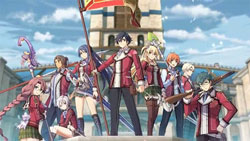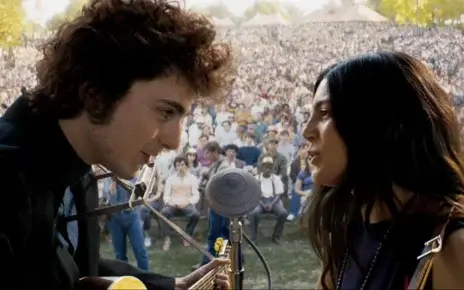 The Legend of Heroes: Trails in the Cold Steel is long and at times nonsensical, much like its title. To be completely honest, I went into Legend of Heroes expecting a 20-ish hour game and a very easy review. The premise of the game is basically teenagers going to school and fighting stuff… Where have I seen this before? Oh, right, Valkyria Chronicles 2, Final Fantasy Type-0, every Persona game ever, Harry Potter, and in a million other cheap knockoffs. The image running with this story actually mirrors one released for Final Fantasy: Type-0, right down to the protagonist holding a flag (no one will accuse this game of being original). Actually, in many ways this game feels like a PG version of Final Fantasy: Type-0; there’s a very similar premise/setting, but no mature content about the horrors of war. That said, as a whole I’m glad that I played The Legend of Heroes: Trails in the Cold Steel, and I look forward to the sequel.
The Legend of Heroes: Trails in the Cold Steel is long and at times nonsensical, much like its title. To be completely honest, I went into Legend of Heroes expecting a 20-ish hour game and a very easy review. The premise of the game is basically teenagers going to school and fighting stuff… Where have I seen this before? Oh, right, Valkyria Chronicles 2, Final Fantasy Type-0, every Persona game ever, Harry Potter, and in a million other cheap knockoffs. The image running with this story actually mirrors one released for Final Fantasy: Type-0, right down to the protagonist holding a flag (no one will accuse this game of being original). Actually, in many ways this game feels like a PG version of Final Fantasy: Type-0; there’s a very similar premise/setting, but no mature content about the horrors of war. That said, as a whole I’m glad that I played The Legend of Heroes: Trails in the Cold Steel, and I look forward to the sequel.
The Legend of Heroes: Trails in the Cold Steel is a fantasy JRPG (Japanese role-playing game) set in a semi-modern world. Gameplay makes use of tactical turn-based combat and several social sim elements (interactions with other characters provide character depth and story information). And, as I may have mentioned earlier, the foundation of its plot is not exactly an original concept; actually, it’s probably the most overused premise in the genre right now. Knowing this, I went into Legend of Heroes not expecting much, and my first hour in-game didn’t change that opinion for the better. I was initially quite unimpressed by Legend of Heroes’ dated graphics and total lack of animated cut scenes; if someone had told me this was a 2007 game, I’d have believed them.
The Legend of Heroes makes no attempts to shy away from familiar genre clichés, and actually it hits just about everyone. Nice-guy protagonist with a dark past and hidden power? Multiple characters with sister/brother complexes? 14-year-old soldier? Obligatory swim suit scene with slightly too convenient camera angles? In-game choices that seem important but turn out not to matter? Yes to all of the above, and a bunch I didn’t have the space to list.
As I’ve spent half this review criticizing The Legend of Heroes, I should probably explain why I like it before I convince everyone that it’s a terrible game. The combat in The Legend of Heroes was what initially started to win me over. Legend of Heroes’ combat system is turn-based and tactical; it’s also unlike anything I’ve ever seen before, which is saying something (I’ve played a lot of turn-based RPGs). Rather than place you in a grid, as is traditional, Legend of Heroes lets you wander around a field; when you encounter an enemy you are transported to a battle screen, and this is where things get interesting.
Battles are fought inside an arena-like circle, and the movement order of characters/enemies is determined by stats. The actions you take affect the delay before your character’s next turn; for example, walking a short distance will cause less of a delay than attacking enemies. Actions involving magic are typically powerful, but require a delay before and after you use them. I found that with the difficulty turned up, Legend of Heroes’ combat took some getting used to. I ended up having to make multiple attempts at a number of battles; in a genre where combat systems seem to become simpler and more accessible with time, this level of challenge was a very pleasant surprise. There are a large number of overlapping systems that players have to understand; at higher levels of difficulty each is essential for victory. Anyone who’s into tactical turn-based games should absolutely check this one out; this is the first time I’ve been impressed by a turn-based combat system in years. Also, I’m not alone in my appreciation; Gameinformer gave The Legend of Heroes the “Best Combat System” award for 2015 RPGs.
Unlike many other prominent titles (looking at you, Persona 4), The Legend of Heroes boasts an impressive number of detailed in-game locations. These are explored in so-called “field studies” which make up about half of the game (the rest is at Thors Military Academy). I felt like I was constantly visiting new places; this helped keep the story fresh and the plot moving forward. It seemed clear that a large amount of effort went into these locations, as each area had its own backstory and a place in the larger narrative. It was also quite interesting visiting different settings and see how the locals felt about political matters. I thought the political aspect of Legend of Heroes was the plot’s biggest draw. The political landscape seems have been loosely based off of mid-18th century Europe; the “blood and iron chancellor” was clearly inspired by Bismarck, and the factions seemed to be split between those who want a republic and those who want a monarchy. At times, it felt almost like the game was letting you go out and discover this stuff yourself.
The Legend of Heroes’ plot, while weighed down by clichés, is quite detailed. The game boasts an unusually large number of unessential NPCs (non-player characters). Each of these characters have unique dialogue, often multiple different lines, which are changed and updated frequently. An incredible amount of writing must have been necessary to do this. In terms of the effort put in, The Legend of Heroes competes with the best of the triple-a crowd. The game’s pricing, $40, is quite reasonable considering the consoles on which it launched (I would have expected $60 on PS3 and $50 for PS Vita).
The studio which designed The Legend of Heroes, Nihon Falcom, apparently have somewhat limited means with which to develop games. They’re not a prominent triple-a developer/publisher and they can’t afford to make big-budget titles like Final Fantasy or Persona. Actually, the only popular Nihon Falcom series in the west is YS; localizing The Legend of Heroes: Trails in the Cold Steel was a financial risk for them. They claimed that there was enough demand from fans to make it feasible, and that they were willing to put the effort in so long as their costs get paid back. In my mind this shows integrity towards their fans; some bigger companies, like Sega, could learn a lot from this example.
If we’re thinking of The Legend of Heroes: Trails in the Cold Steel as a modern triple-a game, then I’d rate it at 8/10, which in my book means “very good.” I don’t feel like that’s completely fair though; The Legend of Heroes is not a modern triple-a game, and the developers chose to price it accordingly. When all was said-and-done, it took me 80 hours to play through The Legend of Heroes (this has something to do with why I’m reviewing a December release in April…). I consider it time well-spent though, and am looking forward to the rest of this trilogy. Suffice it to say I’d strongly recommend this game, particularly if you like old-school JRPGs and tactical combat.
PHOTO COURTESY of www.technobuffalo.com



